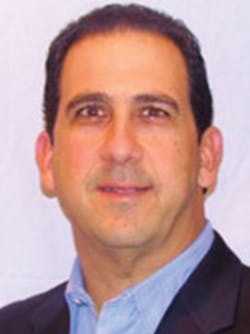Healthcare organizations may point to a variety of reasons that motivate them to pursue sustainable products and services either as alternatives to current products and services under contract or in lieu of more traditional offerings.
Motivations range from environmental awareness, accountability and advocacy, to branding, marketing and promotional/public relations, to simple responsibility and “being the right thing to do.”
Such a progressive mindset, however, can face attitude-oriented and process-related speedbumps (recycled or not) along the way. Some may feel that green or sustainable models are too “costly or inconvenient” to procure or they may question quality or return-on-investment.
While most (if not all) healthcare organizations and professionals are aware of sustainable products and services, not nearly as many have translated that awareness into action.
What are the impediments to a deeper migration to sustainable products and services? Is there a green light at the end of the tunnel?
Event horizon
Chief among the challenges healthcare organizations face when mulling sustainability initiatives and projects remains the simple idea of priority.
“Healthcare organizations are currently under such tremendous pressure to reduce costs, the thought of replacing existing products with a more sustainable product isn’t necessarily a priority,” Dan Constant, President, Sustainable Solutions LLC, Gainesville, GA, told Healthcare Purchasing News. “While environmentally preferred product (EPP) goals are being laid out for the future, currently Procurement, Supply Chain and Sustainability departments are facing an uphill battle in striving to meet these goals.”
Further, Constant points to contractual obligations as a potential hurdle. “A smaller concern is that existing products are under contract, and there doesn’t seem to be a motivation to bring new EPP to market until the existing contracts expire,” he noted.
Constant also cites cultural changes, specifically involving clinical comparison, as a culprit, “even though the products have similar attributes, including plastic composition and molding processes,” he continued. “An interesting issue to overcome is to have healthcare professionals understand that recycled resin acts, feels and performs the same as virgin resin.”
He also expresses concerns about suppliers and group purchasing organizations that can “make it complex for a new product manufacturer to participate in the purchasing process” even as federal regulations in the last few decades and ongoing scrutiny of competitive practices has motivated GPOs to be more open-minded and interested in “new” technologies.
“Developing sustainable solutions and implementing effective recycling programs are critical to helping healthcare facilities reduce their carbon footprint and achieve their sustainability goals,” said Joe Hannibal, Associate Marketing Director, Halyard Health, Alpharetta, GA. “Given that recycling programs can be a tremendous undertaking, it’s important that medical device companies take steps to help simplify this process.”
Halyard launched its Blue Renew Wrap Recycling Program five years ago as a step-by-step approach to recycle used sterilization wrap. As an extension to Blue Renew, Halyard teamed up with Sustainable Solutions to convert its recycled sterilization wrap into BlueCON Resin, which it uses to create green, sustainable hospital products, such as distribution and product totes, garbage cans, bedpans and washbasins.
“From our perspective, BlueCON Resin products derived from Halyard Health’s Blue Renew program are priced competitively to non-environmentally preferred products,” Hannibal said. “The issue that may cause sustainable products to be perceived as more expensive is if distributors and GPOs do not include them with traditional product bundle pricing. Hospitals must demand that comparable environmentally preferred products are included in product categories and have the opportunity to be bundled with other traditional products, which will result in savings to the hospital.” He also added that his company can assist a provider with its EPP purchasing strategies and tactics.
Dollars and sense
Several provider and supplier experts report that cost and convenience — perceived and actual — play key roles in shaping sustainable product purchasing patterns. (See sidebar on Greenhealth and Dignity with office supplies.)
“Perception of greater cost or lack of seed capital to make a change [can be] a primary impediment to adoption of sustainable or more environmentally friendly systems,” said Al LoBiondo, Managing Principal, MedGap Solutions LLC, an energy development company, and President, A.J. LoBiondo Associates LLC, Spring Lake, NJ. “I would also note that the analysis as to the payback on sustainable or more environmentally friendly products is often complex with utilization and total cost-of-use considerations often difficult to quantify. In the world of energy efficiency, where capital investment can be significant, the availability of third-party grants or off-balance-sheet financing provides some options to both meet environmental goals and show financial returns.”
The debate centers on the purchase cost vs. total cost of use when comparing sustainable to traditional products, according to LoBiondo. “The challenge is to accurately assess true cost when you consider the cost of storage and disposal and safety and health implications for the work and caregiving environment,” he said.
“The number of key priorities for all of us can be endless,” Born said. “Considering sustainability in our product decisions can seem like something that requires too much effort, but if you weave it into the fabric of your operations, it can become a habit that does not require extra effort yet delivers positive benefits.”
Fairview has found ways to go green and save money, according to Born, and have experienced “very few situations” where they had to pay more for something to go green.
“It helps to define ‘cost,’” she noted. “Some products might cost more to produce and therefore, cost our organization more through the purchase, but if it does not harm people or the environment or does not need to enter the waste stream, we could be saving at the point of consumption. Short-term investments in better lighting and water-saving devices have long-term financial benefits to lower electricity and water bills. In the areas of energy consumption, packaging, waste management and transportation, we’ve actually saved money through making sustainable choices. Eliminating the seldom used products in custom procedure trays costs less at the time of production and purchase and eliminates the need to throw away the unused product.”
Supply Chain executives just have to be smart when it comes to determining whether sustainable products cost more than their traditional counterparts, according to Jim Olsen, Senior Vice President, Materials Resource Management, Carolinas HealthCare System, Charlotte, NC.
“There is no absolute answer,” Olsen noted. “Some are less expensive and others are more expensive. Products that are sold as green and nothing else seem to be more expensive. We try to look at the total value the products provide, including the cost of recycling, reprocessing or disposal, impact on patients, etc. Green is a priority but it is not the only priority. We need to be responsible stewards of our resources.”
Energy production vs. acquisition represents another discussion point, LoBiondo said. “When we get into energy, we have to consider the environmental footprint for producing energy onsite vs. the entire production and delivery network associated with a kilowatt of power,” he said. You also have to figure out the value of having the resiliency of on-site power generation when the utility is down. The economics and ecological objectives are often mutually attainable.”
Defining truth
Fundamentally, healthcare organizations may not have a clear and thorough education and understanding about what constitutes and defines environmentally friendly, green, sustainable products and where to get them. Reston, VA-based Greenhealth Exchange (GX)a GPO dedicated to environmentally friendly and sustainable products, has been working to improve this since its debut last year.
“In addition to clearly identifying what is truly a greener, more sustainable product based on member and industry expert knowledge, the operator has to navigate through their existing contractual relationships and the typical product review procedures,” said John Strong, GX President. “GX members are doing this within their systems because sustainability is a priority and typically integrated into the organization’s mission. (See sidebar on what GX and Dignity Health shared about office supplies at the AHRMM conference in late July.)
Strong notes that GX exists to help healthcare organizations identify available sustainable products by “creating a catalog of products vetted against a set of standards developed and approved by [GX] members and industry experts,” he said. With product research and reviews performed, GX members can make more informed choices about green product options, according to Strong. The GPO then leverages its collective contractual volume by those provider members for better pricing.
Strong disputes the notion that sustainable products generally are more expensive than traditional products. “We have members that are not only achieving savings from our contracts, but are also increasing their use of truly green/sustainable products by as much as 100 percent,” he insisted. “These results may not be the same for all categories, and in some cases, there is a real increase in costs to greener products, such as local/regional and antibiotic-free meats and poultry. But in many cases, focusing volume on those products that meet our specifications [to be green or sustainable] can result in either similar or lower pricing for members.”
Tony Lively, President, ZRG LLC, an Oceanside, CA-based company that handles electronic device recycling, concurs that “education and outreach towards greener products and services” remains a challenge. He calls for a universal buyer’s guide dedicated to those products and services as well as “better access to sustainability engagement coordinators” as potential solutions.
Lively acknowledges the “push in many vertical markets, including healthcare, to become a more sustainable marketplace,” and mentions the internet-accessible EPEAT rating system for “greener electronics” as an effective online product research tool for lifecycle and disposal information. Yet simple economics should impact prices over time, he added. “I think as new [green] products roll out there is a higher initial start-up cost, but as the products become more recognized and purchased the manufacturing costs will come down,” he noted.
Tim Cole, Vice President, Marketing, nora systems Inc., Salem, NH, attests to the educational hurdles when it comes to evaluating durable heavy-use flooring options for construction and renovation projects.
“There is a misconception that rubber flooring is very expensive,” Cole indicated. “Although it may not be the least expensive option upfront, when evaluated throughout its entire life cycle, rubber flooring presents very good long-term value and a reduced total cost of ownership — one that often is better than seemingly less expensive flooring products.” He cites that cleaning and maintenance with water and not finishes and sealants can make a difference, along with a wide variety of design selections.
Choosing between forced-air hand dryers and paper towel dispensers illuminate the issue for William Gagnon, Vice President of Marketing and Sales, Excel Dryer, Inc., East Longmeadow, MA.
For Gagnon, the decision involves misperceptions about effectiveness, efficiency, hygiene and the environmental considerations.
“Sustainable products are often unfairly associated with higher costs than traditional counterparts,” he lamented. “For example, hand dryers could be viewed as more expensive options for high-traffic restrooms because of the electricity used. However, facilities receive a significant cost savings when they switch from paper towels to our energy-efficient hand dryers — to the tune of 95 percent cost savings, in fact.”
Gagnon attributes the cost savings to a one-time purchase and installation fee and less labor and maintenance needs when compared to hospital staff purchasing, transporting, stocking, storing and replenishing paper towel dispensers more frequently in multiple locations.
Misconceptions about hygienic and environmental benefits can perplex purchasers as well, according to Gagnon.
“It is a common misconception that paper towels are more hygienic than hand dryers,” Gagnon noted. “The fact is, germ removal happens through proper hand washing, regardless of drying method.” He cites several independent studies that show that drying with paper, cloth or forced air doesn’t impact germ removal, but that germs left on hands from improper handwashing techniques can be spread much more easily and effectively using paper or cloth towels for drying than filter-equipped forced-air hand dryers. Using another lifecycle assessment study he also dismissed the notion that paper towels made from 100 percent recycled content are “better for the environment” than even traditional electric hand dryers in terms of climate-changing energy consumption.
Born emphasizes the need for achieving balance.
“Two current areas of concern for me relate to finding the right balance between disposable vs. reusable products and figuring out how we can benefit from the growing conveniences of rapid delivery while reducing the waste related to packaging and transportation inefficiencies,” she said. “In some situations, the environmental impact of disposable products is less than the impact of reprocessing the reusable. Although it pains me to add more to the waste stream, it may actually be better for the environment than the energy and water used to reprocess. I like the convenience of quick deliveries, but often these involve more packaging and more deliveries using more inefficient vehicle time.”
Inconvenient consequences?
The specter of inconvenience can weigh heavily on a sustainable decision to go green. Inconvenience may involve commercial accessibility and availability as well as common use and the consequences of use.
Gagnon points to paper towels as more inconvenient than hand dryers based on disposal behaviors. And he’s not referring to trash-hauling, but plumbing.
“Many hospitals and healthcare settings have begun to start using our high-speed, energy-efficient hand dryer because they have low-flow toilets, which clog much easier from paper towels,” Gagnon said. “This is not only inconvenient, but it occurs more frequently than you think. A prime example of this occurred at Northwestern Memorial Hospital in Chicago. Soon after they converted from paper towel dispensers to hand dryers, the hospital’s facility managers reported they had all but eliminated their plumbing problems.”
Perhaps the most inconvenient aspect of green or sustainable products is determining just how green or sustainable a product really is and whether it lives up to its environmentally friendly label claims.
Mary Starr, GX Vice President of Member Services, contends that hospitals should evaluate green and sustainable products with the same passion and veracity as they do traditional products. Why should the evaluative process be any different?
“Why isn’t the process of evaluating these products seen as any other evaluative process?” Starr asked. “Given the impact harmful chemicals in plastics and flame retardants can have on our patients when they are found in medical products and furnishings, it would seem to us that it has to be part of the standard evaluation and a factor included in determining the acceptability and efficacy of a product. Yes, there may be some procedural changes required, but isn’t that what is continually happening as our organizations work to improve outcomes and the quality of patient care — whether the product is considered one with sustainability features?”
GX has been working with one supplier to remove Teflon-like materials from some of their products, according to Starr. “They are willing to do it, and have built prototype products,” she said. “Some of our facilities have been testing them, and we’ve discovered there are issues with the alternatives. Together, we will keep working on solutions even though the volume of products we are talking about is somewhat modest.”
Starr acknowledges concerns in some cases of whether green/sustainable products work as well as current or previous products in general use and are evaluating for that.
“Green products certainly should not take more effort to evaluate, and in general they need to stand up to, and perform as well as their brown competition at an affordable price,” Starr continued. “GX’s mantra is that green should not cost more — except in a few legitimate cases where higher standards require greater expense. An example of this area might be organic farming, and processing of these products. There are certainly some added costs here. But again, with proper scaling and seller motivation we think some or most of these can be mitigated over time.”
Strong cautions against accepting green or sustainability labels at face value unless those label claims have been verified against some set of accepted standards.
“There are a lot of so-called sustainable products on the market that may only have one green or sustainable attribute to achieve that listing,” he noted. “GX looks at carefully selected attributes and standards, and seeks consensus with our owners about these attributes before we contract for anything. This work is not being done by others, although some would espouse to providing solutions.”
At least two GX members are earning raves as they’re making waves — Gundersen Health System, La Crosse, WI, and Mayo Clinic, Rochester, MN. Both are involved in a farmer-owned cooperative that includes buying local, organic produce to serve patients, families and visitors, according to Strong. Gunderson also concentrates on internally produced renewable energy and has increased its pursuit of environmentally preferable purchasing contracts. In fact, Gunderson’s sustainability initiatives have resulted in more than $3 million in annual savings, according to Strong.
“GX seeks to continually replace brown product with green, offer suppliers opportunities to scale production and make products available to healthcare providers that are truly concerned about the health of their communities as well as what they are using to construct their facilities and treat their patients,” Strong said. “All of the products in the GX catalog have been vetted against sustainability standards that we set with our members and industry experts. This includes categories such as office supplies, building materials, furnishings, food and cleaners. We are working on medical products now with a focus on those areas we believe should be given priority for conversion to products void of harmful chemicals.”
See also: Going green without seeing red?
About the Author
Rick Dana Barlow
Senior Editor
Rick Dana Barlow is Senior Editor for Healthcare Purchasing News, an Endeavor Business Media publication. He can be reached at [email protected].











